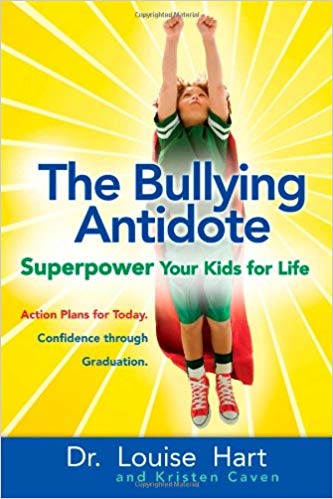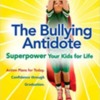Parents have more power than anyone else to prevent bullying and other risky behaviors in young children. There is great power in their love, connection, and influence. Parents have the power to protect, nurture, engage, and teach. They put their child’s feet on the right path and redirect them when they go astray. Parents also have the power to prevent bullying by changing family dynamics. They may not know it, and they may not know how to do it.
Parents also have authority to create a positive climate based on belonging, connection, respect and the Golden Rule (“Do unto others as you would have them do unto you”). They have the authority to establish family rules, such as “Disrespect is not acceptable,” and, “Bullying is not tolerated.” Parents have the authority to teach morality— what’s right and what’s wrong—and what’s acceptable and not acceptable.
Parents have tremendous power to build inner strength and self-esteem that protect children against the troubles the world will bring.
If parents don’t shape their kids, their kids will be shaped by outside forces—forces that don’t care what shape they are in!
Unfortunately, some common parenting practices considered to be “normal”—actually foster bullying. Sadly, they do not realize they are actually teaching The Bullying Dynamic!
How “Regular” Parents Unknowingly Raise Bullies
“The Father of Anti-Bullying Programs,” Dr. Dan Olweus, studied bullying problems in Europe for more than 35 years. Dr. Dan found that widespread and common child-rearing practices are linked to the development of what he calls anti-social behaviors in children, including “hostile reaction patterns.” Common at all levels of income, and in all races, they are:
- Negativity on the part of the primary caretaker. When children sense negativity instead of the warm connections they need, they feel insecure and unsafe. This increases the risk of aggression and hostility.
- Permissiveness for aggressive behavior. Youngsters are more likely to bully when they can get away with it, and when there are no consequences.
- Use of “power-assertive methods.”When parents don’t know what else to do, they commonly try to resolve conflict with power, aggression and violent emotional outbursts. Children raised with spanking, yelling, and punishments are likely to become aggressive. Not respecting your child’s feelings damages their innate sense of right and wrong which could turn them into bullies
When parents understand these conditions, they can work to curb bullying by:
- Conveying warmth and engaging positively
- Setting clear and positive expectations for desired behavior
- Setting firm limits on unacceptable behavior
- Modeling positivesolutions, e.g., never using emotional or physical violence to control a child’s behavior.
A Growing Cultural Movement
Fortunately, a growing cultural movement is opening new possibilities for halting bullying and creating safer environments for kids.
Change-makers are speaking up. For example, in 2011, President Obama and the First Lady hosted a daylong White House Conference on Preventing Bullying. In his opening remarks to this first-ever event, the President stated, “If there’s one goal of this conference, it’s to dispel the myth that bullying is just a harmless rite of passage or an inevitable part of growing up. It’s not.”
Schools need to work extra hard to create positive cultures and safe environments. Parents can be pro-active in getting effective programs that teach pro-social skills at the school. But most importantly, parents can learn Positive Parenting skills to and learn the democratic/ win-winleadership style.
From Bystander to “Upstander”
In a typical bullying event, there is generally one bully, one victim, and a group of bystanders. Traditional thinking puts the burden on the victim for handling, reporting, solving, permitting, or even causing the bullying. As more is learned about the bullying dynamic, we realize this thinking is unjust and unhelpful for actually solving the problem.
“The world is dangerous not because of those who do harm, but because of those who look at it without doing anything.”—Albert Einstein.
Moreover, witnesses are deeply affected because a witness to violence is a victim of violence. Here’s good news: we can empower passive bystanders to become “upstanders.” Upstanders realize that they have a choice: they ask themselves, “What can I do to help make things better?”
Upstanders make a difference by getting help, speaking up, and reporting what they saw; consequences naturally follow.
The Power of Upstanders
Upstanders have great power to:
- Stop bullying before it starts
- Curb a bullying event
- Support the victim; reduce the trauma
- Look for help when the victim cannot
- Encourage others to be compassionate and also help stop bullying
- Give a strong message that bullying is not okay
- Set an example of doing the right thing
- Model assertiveness
The upstanders movement is widespread, effective, and catching on like wildfire. You can help create a community of upstanders and help build a stronger, safer society.
Assertive Skills: Part of the Solution
In researching bullying, the authors of The Bullying Antidote were surprised to discover the effectiveness of assertive skills. Assertive youngsters are less likely to become bullies or to attract bullies. Because they have better social skills, they can get their needs met by asking, and saying “no”, and setting boundaries.
The international best-selling children’s book, The Mouse, the Monster and Me: Assertiveness for Young People, describes the three basic communication styles—Passive, Aggressive,and Assertive—using a clever metaphor. “When you use mouse or monster ways to get what you want,” writes Dr. Pat Palmer, “you feel bad, and so does everyone else around you.”
The assertive “ME” is about asking for what you need/want, saying “no” to what you don’t want, and setting personal boundaries. “Being assertive means you are letting yourself and others know what you want, not in a pushy way like monsters do, or a scared way like mice do, but in an honest way by just being YOU,” writes Palmer. It’s best to learn these skills together with your children and/or partner, so both are on the same page and can support each other.
Learning new skills, aggressive kids (and adults) can get needs met without getting mad, shouting, hitting, or having a tantrum… Passive kids can find their voice and just ask, instead of hinting, pouting, whining, or crying… When youngsters and grown-ups learn and practice these nonviolent interaction tools, they are on track for healthy win-win relationships.
Assertiveness skills give men and women, boys and girls a common language and interaction style. Assertiveness skills can set everyone on a positive trajectory that can benefit them throughout their lives.
_________________________
Excerpted from The Bullying Antidote: Superpower Your Kids for Life by Dr. Louise Hart and Kristen Caven—a mother-daughter team. Hart, a community psychologist, is also the author of The Winning Family: Increasing Self-Esteem in Your Children and Yourself, and On the Wings of Self-Esteem. Caven also wrote Perfectly Revolting and The Souls of Her Feet. (www.upliftpress.com)





Comments (1)